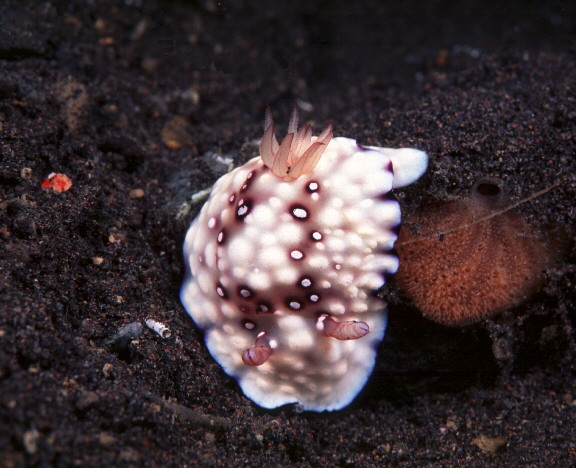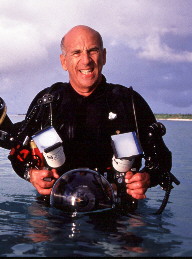
| Chromodoris hintuanensis Photo courtesy of Steve Drogin Tulamben, Bali, Indonesia Oct., 1997 |
Chromodoris hintuanensis Gosliner & Behrens, 1998
The second "Branch of the Week" of five species recently described in our Proceedings of the California Academy of Sciences paper, is Chromodoris hintuanensis. Since it was first collected on an un-named stretch of Balayan Bay reef, this species has been referred to simply as Chromodoris "Bus Stop". Unusual name - not for the merry band of branchers who first collected the gem. The story goes, that as Terry and Mike Miller surfaced with the first specimens in hand, the only recognizable feature along the beautiful Luzon shoreline was a shed, occupied by locals waiting for their bus to Manila. While the Tagalog dialect has no word specific for Bus Stop, we have chosen "hintuan" meaning "stopping place" referring to the type locality as the specific name of the species.
Chromodoris hintuanensis reaches about 16 mm in length. The body is white, with the dorsal surface covered with irregularly- shaped nodules of varying sizes. The mantle margin is edged with deep violet which, in areas of mantle folding, extends inward from the edge to form small patches of color, as seen in this specimen and the misidentified photo, Debelius, 1996, bottom of page 210. Small circles of deep magenta outline 5-8 of the small, opaque white, rounded nodules in the medial region, and near the base of the rhinophores. The rhinophores and gills are dull plum color. Crimson lines are present along the longitudinal edges of the gill plumes and on the rachis and lamellae of the rhinophores.
Chromodoris hintuanensis belongs to a group of species in which the anterior end of the body is rhythmically raised and lowered as the animal crawls. Included in this group is Chromodoris geometrica Risbec, 1928 and C. conchyliata Yonow, 1984. The three species are quite similar in external coloration and have been mixed up in some of the recent literature. While the most dramatic differences are in the internal anatomy, the three can be separated externally as, "Bus Stop" has a network of pale plum areas while in C. geometrica the network is dark brown to black, and in C. conchyliata it is deep purple. C. geometrica has yellowish-green rhinophores and gills, with opague white spots, while in C. conchyliata the gills have red lines along the rachis, but the rhinophores are uniformly red.
With the help of some friends, "Bus Stop" is known from Bali, Indonesia, Steve's photo shown above, (Debelius, 1996); Papua New Guinea (photo by Jim Black); Okinawa, Ryukyu Islands (photos by Bob Bolland); the Andaman Sea, Thailand (photos by Mark Strickland); and at several locations in the Batangas Province of the Philippines (collections by Webmaster Miller and the authors).
A bus stop may be an unlikely place to meet a nudibranch, but in Batangas, one never knows.
Photo courtesy of James D. Watt
Kona, Hawaii

Steve is a 58 year old amateur Diver/Photographer who spends full time traveling and diving the globe. He lives in La Jolla, California and is a member of the San Diego Underwater Photographic Society. His photographic credits include a recent article on the sunken fleet of Bikini Atoll in Sports Divers Journal(Issue 16) . Send Steve mail at sbdrogin@mill.net |
Taxonomic information courtesy of:

David W. Behrens
Author:
Pacific Coast Nudibranchs
Send Dave mail at seachalleng@earthlink.net
|
